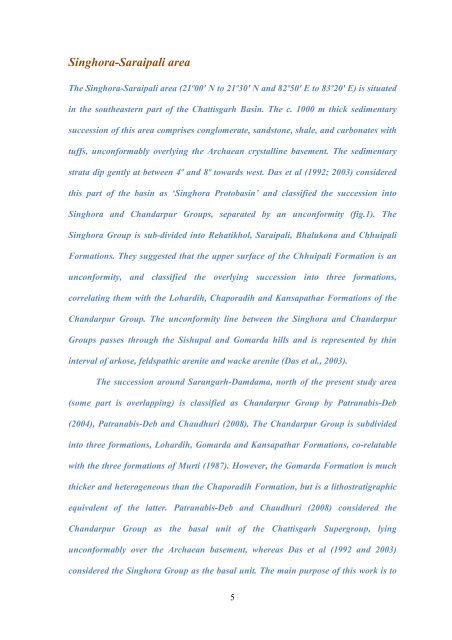of the Singhora-Saraipali area, south-eastern Chattisgarh Basin - fieldi
of the Singhora-Saraipali area, south-eastern Chattisgarh Basin - fieldi
of the Singhora-Saraipali area, south-eastern Chattisgarh Basin - fieldi
You also want an ePaper? Increase the reach of your titles
YUMPU automatically turns print PDFs into web optimized ePapers that Google loves.
<strong>Singhora</strong>-<strong>Saraipali</strong> <strong>area</strong><br />
The <strong>Singhora</strong>-<strong>Saraipali</strong> <strong>area</strong> (21º00' N to 21º30' N and 82º50' E to 83º20' E) is situated<br />
in <strong>the</strong> sou<strong>the</strong>astern part <strong>of</strong> <strong>the</strong> <strong>Chattisgarh</strong> <strong>Basin</strong>. The c. 1000 m thick sedimentary<br />
succession <strong>of</strong> this <strong>area</strong> comprises conglomerate, sandstone, shale, and carbonates with<br />
tuffs, unconformably overlying <strong>the</strong> Archaean crystalline basement. The sedimentary<br />
strata dip gently at between 4º and 8º towards west. Das et al (1992; 2003) considered<br />
this part <strong>of</strong> <strong>the</strong> basin as ‘<strong>Singhora</strong> Protobasin’ and classified <strong>the</strong> succession into<br />
<strong>Singhora</strong> and Chandarpur Groups, separated by an unconformity (fig.1). The<br />
<strong>Singhora</strong> Group is sub-divided into Rehatikhol, <strong>Saraipali</strong>, Bhalukona and Chhuipali<br />
Formations. They suggested that <strong>the</strong> upper surface <strong>of</strong> <strong>the</strong> Chhuipali Formation is an<br />
unconformity, and classified <strong>the</strong> overlying succession into three formations,<br />
correlating <strong>the</strong>m with <strong>the</strong> Lohardih, Chaporadih and Kansapathar Formations <strong>of</strong> <strong>the</strong><br />
Chandarpur Group. The unconformity line between <strong>the</strong> <strong>Singhora</strong> and Chandarpur<br />
Groups passes through <strong>the</strong> Sishupal and Gomarda hills and is represented by thin<br />
interval <strong>of</strong> arkose, feldspathic arenite and wacke arenite (Das et al., 2003).<br />
The succession around Sarangarh-Damdama, north <strong>of</strong> <strong>the</strong> present study <strong>area</strong><br />
(some part is overlapping) is classified as Chandarpur Group by Patranabis-Deb<br />
(2004), Patranabis-Deb and Chaudhuri (2008). The Chandarpur Group is subdivided<br />
into three formations, Lohardih, Gomarda and Kansapathar Formations, co-relatable<br />
with <strong>the</strong> three formations <strong>of</strong> Murti (1987). However, <strong>the</strong> Gomarda Formation is much<br />
thicker and heterogeneous than <strong>the</strong> Chaporadih Formation, but is a lithostratigraphic<br />
equivalent <strong>of</strong> <strong>the</strong> latter. Patranabis-Deb and Chaudhuri (2008) considered <strong>the</strong><br />
Chandarpur Group as <strong>the</strong> basal unit <strong>of</strong> <strong>the</strong> <strong>Chattisgarh</strong> Supergroup, lying<br />
unconformably over <strong>the</strong> Archaean basement, whereas Das et al (1992 and 2003)<br />
considered <strong>the</strong> <strong>Singhora</strong> Group as <strong>the</strong> basal unit. The main purpose <strong>of</strong> this work is to<br />
5









